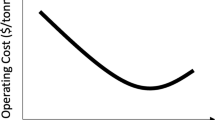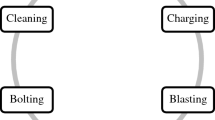Abstract
The top-down extraction sequence in the sublevel open stope method leaves rib pillars to support the excavations, so the stability of the pillars and stopes makes dilution control critical in this method. This work introduces an integrated methodology for the net profit and geomechanical optimization of the layout of open stopes and rib pillars with the use of a genetic algorithm. Parameters such as the minimum size of stopes, minimum size of pillars, maximum accepted dilution, and maximum acceptable percentage of pillar failure need to be informed by the user. A profit function capable of attributing economic value to the geometric set analyzed, including the geomechanical performance, is established. The geomechanical performance of the geometric sets is obtained by autonomous numerical models in the FLAC3D software and includes the average percentage of pillar failure and the potential dilution. The algorithm is verified using a case study of a mining panel of an underground gold mine with a top-down mining sequence. An 8% increase in net profit was obtained relative to the engineer’s design method, considering 70% of hangingwall support efficiency for both methods. The percentage of pillar failure decreased threefold. When considering no hangingwall support, the net profit increase is 22% relative to the engineer’s design method. The proposed methodology proved that it is possible to carry out an integrated optimization, considering the costs inherent to mining and the cost of the geomechanical performance, reducing the need for secondary support compared to the engineer’s methodology.








Similar content being viewed by others
Data Availability
The code that support the findings of this study are available from the corresponding author upon request. The case study data are not publicly available due to data use restrictions.
References
Villaescusa E (2014) Geotechnical Design for Sublevel Open Stoping. CRC Press, Boca Raton
Sari YA, Kumral M (2023) Stope sequencing optimization for underground mines through chance-constrained programming. Mining Metal Explor. https://doi.org/10.1007/s42461-023-00821-2
Alford C (1995) Optimisation in underground mine design. In: Proceedings of the 25th APCOM Symposium. Australasian Institute of Mining and Metallurgy, Melbourne, pp 213–218
Mitchell M (1998) An introduction to genetic algorithms. The MIT Press, London. https://doi.org/10.7551/mitpress/3927.001.0001
Coley DA (1999) An introduction to genetic algorithms for scientists and engineers. WORLD SCIENTIFIC, Singapore. https://doi.org/10.1142/3904
Wang H, Tenorio V, Li G, Hou J, Hu N (2020) Optimization of trackless equipment scheduling in underground mines using genetic algorithms. Mining Metal Explor 37(5):1531–1544. https://doi.org/10.1007/s42461-020-00285-8
Riddle JM (1977) A dynamic programming solution of a block-caving mine layout. In: Proceedings The 14th APCOM Symposium. Society of Mining Engineers-American Institute of Mining, Metallurgy, and Petroleum Engineers, New York, pp 767–780
Ataee-Pour M (2000) A heuristic algorithm to optimise stope boundaries. PhD thesis, University of Wollongong. http://ro.uow.edu.au/theses/2923
Johnson TB, Sharp WR (1971) A three-dimensional dynamic programming method for optimal ultimate open pit design. U.S. Department of the Interior, Washington, Bureau of Mines
Topal E, Sens J (2010) A new algorithm for stope boundary optimization. J Coal Sci Eng 16:113–119. https://doi.org/10.1007/s12404-010-0201-y
Alford Mining Systems (2016) Mineable Shape Optimiser. http://alfordminingsystems.com/?page_id=74 Accessed 28 Aug 2023
Alford C (2006) Optimization in underground mine design. PhD thesis, Department of Mathematics and Statistics, The University of Melbourne
Deng J, Yue ZQ, Tham LG, Zhu HH (2003) Pillar design by combining finite element methods, neural networks and reliability: a case study of the Feng Huangshan copper mine, China. Int J Rock Mech Mining Sci 40:585–599. https://doi.org/10.1016/S1365-1609(03)00042-X
Souza F (2011) Dimensionamento ótimo de realces abertos/câmaras inclinadas e pilares via programação matemática não-linear. PhD thesis, Federal University of Ouro Preto
Figueiredo, R.P., Curi, A.: Dimensionamento ótimo de painéis, câmaras e pilares com programação não-linear. In: Proceedings \(1^\circ \) Simpósio Íbero-Americano de Engenharia de Minas, pp. 565–573 (2004). https://doi.org/10.13140/RG.2.1.3805.9921
Andrade AB, Faria ARC, Rampazzo PCB (2019) Economic optimization of rib pillars placement in underground mines. In: Proceedings of the 39th International Symposium on Application of Computers and Operations Research in the Mineral Industry, APCOM, pp. 292–299. https://doi.org/10.1201/9780429320774-34
Napa-García GF, Câmara TR, Torres VFN (2019) Optimization of room-and-pillar dimensions using automated numerical models. Int J Mining Sci Technol 29:797–801. https://doi.org/10.1016/j.ijmst.2019.02.003
Heidarzadeh S, Saeidi A, Rouleau A (2019) Evaluation of the effect of geometrical parameters on stope probability of failure in the open stoping method using numerical modeling. Int J Mining Sci Technol 29:399–408. https://doi.org/10.1016/j.ijmst.2018.05.011
Foroughi S, Hamidi JK, Monjezi M, Nehring M (2019) The integrated optimization of underground stope layout designing and production scheduling incorporating a non-dominated sorting genetic algorithm (nsga-ii). Resour Policy 63:101408. https://doi.org/10.1016/j.resourpol.2019.101408
Sari YA, Kumral M (2020) A planning approach for polymetallic mines using a sublevel stoping technique with pillars and ultimate stope limits. Eng Opt 52:932–944. https://doi.org/10.1080/0305215X.2019.1624739
Sipeki L, Newman AM, Yano CA (2020) Selecting support pillars in underground mines with ore veins. IISE Trans 52:1173–1188. https://doi.org/10.1080/24725854.2019.1699978
Diederichs MS (1999) Instability of hard rockmasses, the role of tensile damage and relaxation. PhD thesis, University of Waterloo. http://hdl.handle.net/10012/480
Castro LAM, Bewick RP, Carter TG (2012) An overview of numerical modelling applied to deep mining. In: Sousa LR Jr, EV, Fernandes MM, Azevedo R (eds) Innovative Numerical Modelling in Geomechanics. CRC Press, London, pp 405–426
Cordova DP, Zingano AC, Gonçalves IG (2022) Unplanned dilution back analysis in an underground mine using numerical models. REM Int Eng J 75:379–388. https://doi.org/10.1590/0370-44672021750093
Itasca Consulting Group Inc (2005) Flac 5 Fast Lagrangian Analysis of Continua Manual. Itasca, Minneapolis, p 3058
Furtney, J.: Itasca (2020) Python package version 2020.7.12. https://pypi.org/project/itasca/ Accessed 28 Aug 2023
Brown ET, Hoek E (1978) Trends in relationships between measured in-situ stresses and depth. Int J Rock Mech Mining Sci Geom Abstr 15:211–215. https://doi.org/10.1016/0148-9062(78)91227-5
Sheorey PR (1994) A theory for in situ stresses in isotropic and transversely isotropic rock. Int J Rock Mech Mining Sci Geomech Abstr 31:193. https://doi.org/10.1016/0148-9062(94)91070-7
Potvin Y (1988) Empirical open stope design in Canada. PhD thesis, University Of British Columbia. http://hdl.handle.net/2429/29264
Nickson SD (1992) Cable support guidelines for underground hard rock mine operations. PhD thesis, University of British Columbia. https://doi.org/10.14288/1.0081080
Clark L, Pakalnis R (1997) An empirical design approach for estimating unplanned dilution from open stope hangingwalls and footwalls. In: Proceedings of the 99th Annual General Meeting. Canadian Institute of Mining, Metallurgy and Petroleum Vancouver
Lunder PJ, Pakalnis RC (1997) A determination of the strength of hard-rock mine pillars. CIM Bulletin 90:51–55
Acknowledgements
The authors would like to thank Micromine for providing the academic software license. They also thank the Federal University of Pampa (UNIPAMPA) for providing the necessary infrastructure, the Rock Mechanics Lab at Federal University of Rio Grande do Sul (UFRGS) for granting the FLAC3D 7 license, and the Brazilian National Council for Scientific and Technological Development (CNPq) for financial support (process 407752/2022-6).
Funding
This work was supported by Micromine providing the academic software license, Federal University of Pampa (UNIPAMPA) for providing the necessary infrastructure, Rock Mechanics Lab at Federal University of Rio Grande do Sul (UFRGS) for granting the FLAC3D 7 license, and the Brazilian National Council for Scientific and Technological Development (CNPq) for financial support (process 407752/2022-6).
Author information
Authors and Affiliations
Contributions
Diogo Peixoto Cordova: conceptualization of this study, collected data, methodology, software. Andre Cezar Zingano: software, methodology, provided expert feedback. Italo Gomes Gonçalves: software, methodology, provided expert feedback.
Corresponding author
Ethics declarations
Competing Interests
The authors declare no competing interests.
Ethics Approval
Not applicable
Additional information
Publisher's Note
Springer Nature remains neutral with regard to jurisdictional claims in published maps and institutional affiliations.
Rights and permissions
Springer Nature or its licensor (e.g. a society or other partner) holds exclusive rights to this article under a publishing agreement with the author(s) or other rightsholder(s); author self-archiving of the accepted manuscript version of this article is solely governed by the terms of such publishing agreement and applicable law.
About this article
Cite this article
Cordova, D.P., Zingano, A.C. & Gonçalves, I.G. A Heuristic Methodology for Economic and Geomechanical Optimization in Sublevel Open Stoping Mining Method. Mining, Metallurgy & Exploration (2024). https://doi.org/10.1007/s42461-024-00980-w
Received:
Accepted:
Published:
DOI: https://doi.org/10.1007/s42461-024-00980-w




